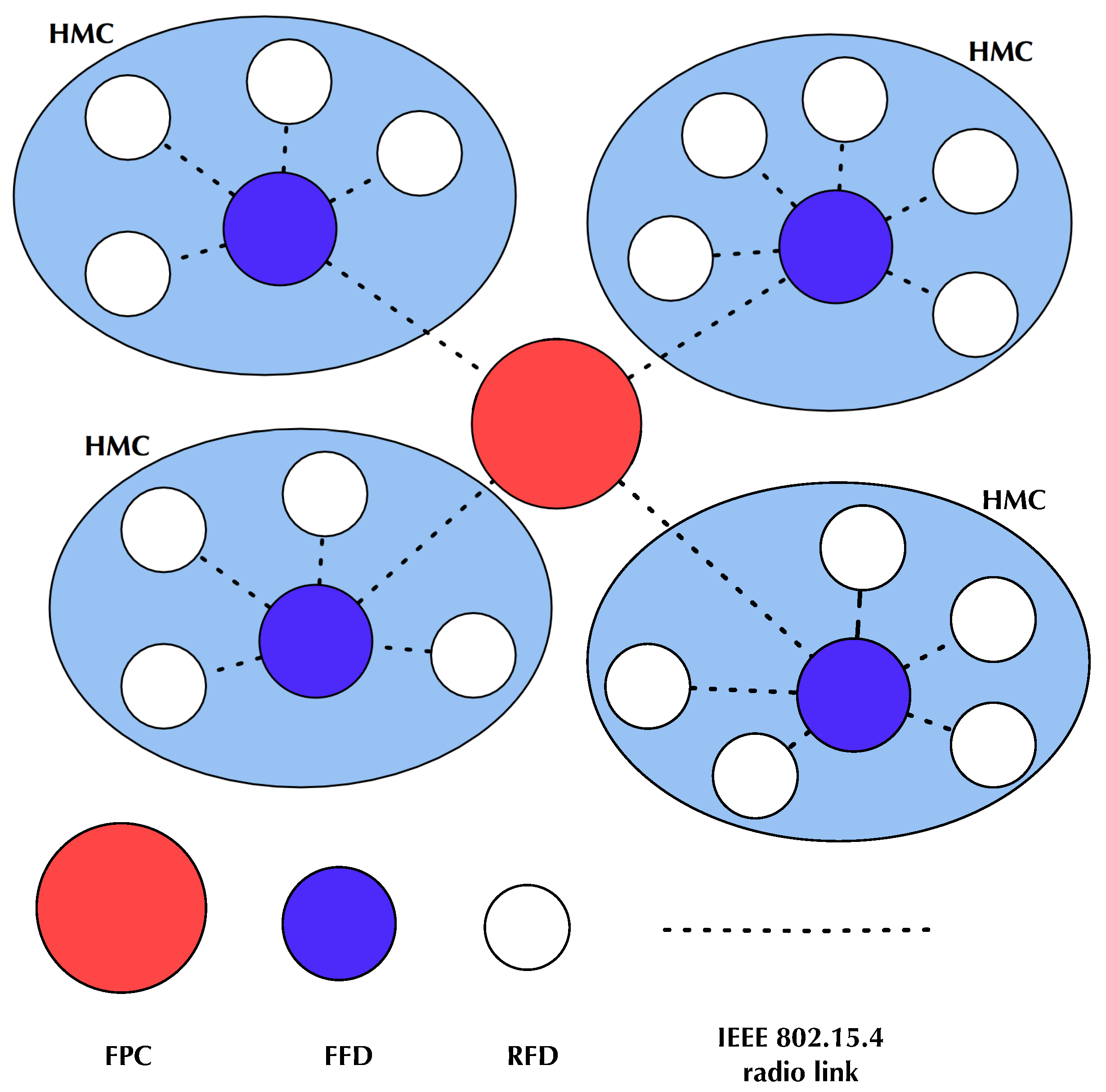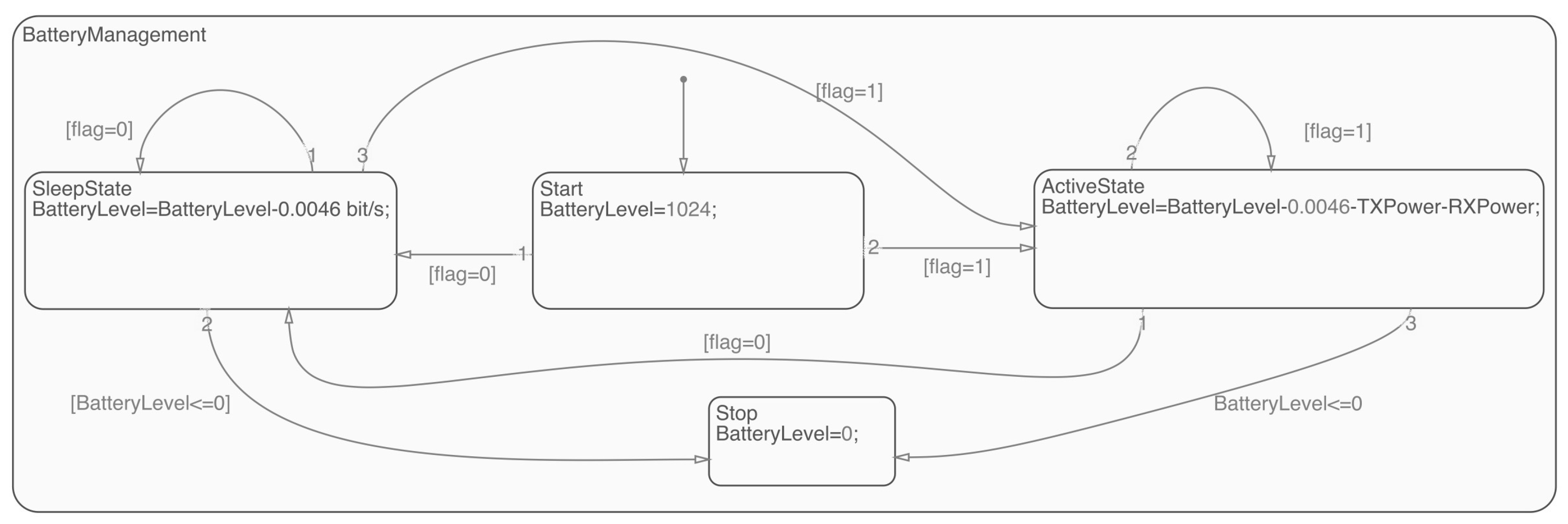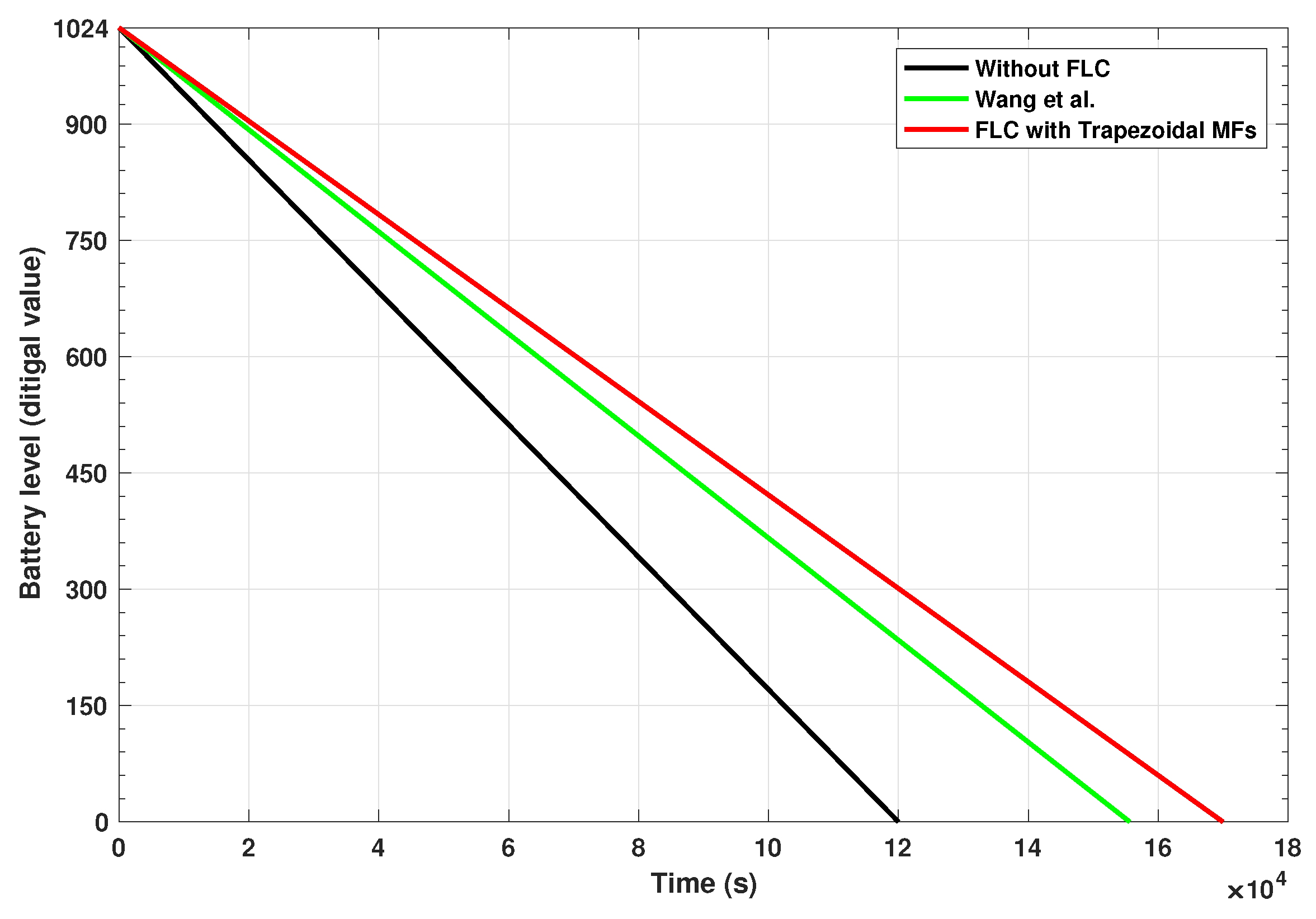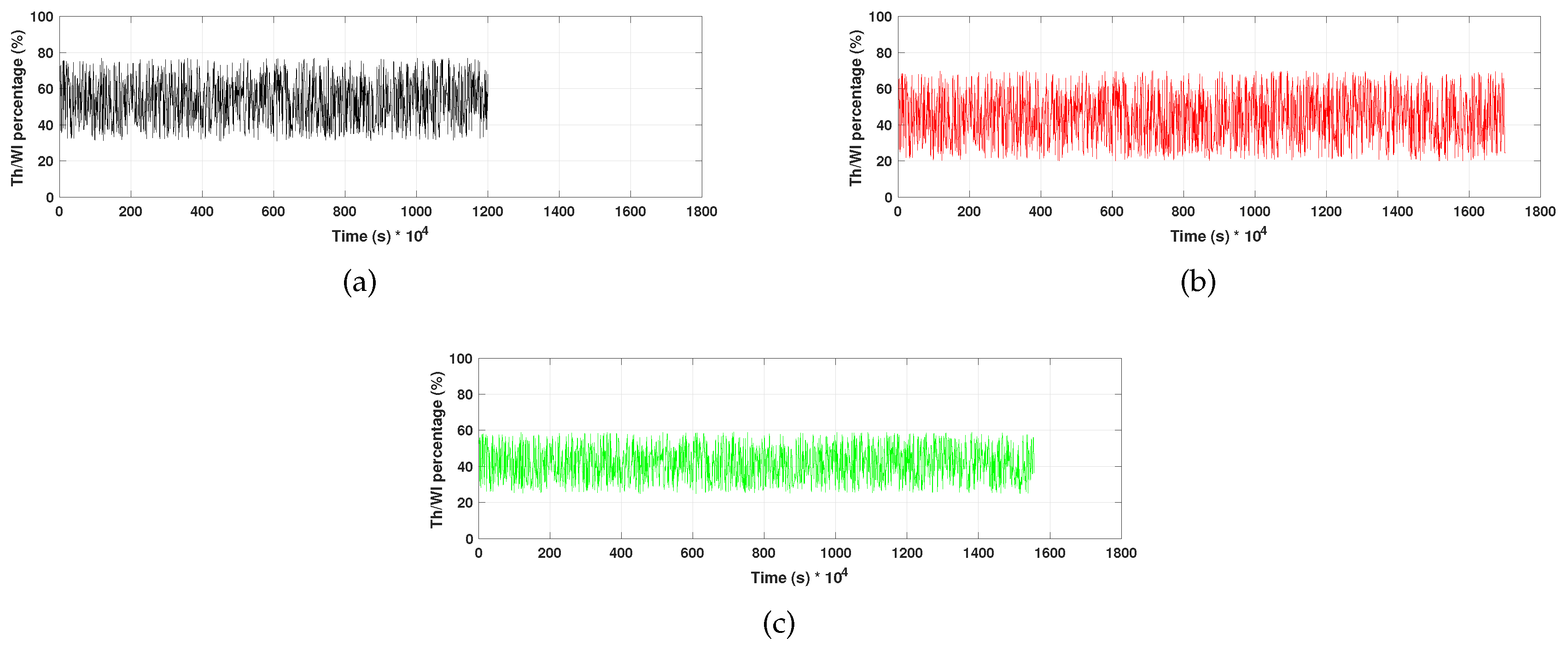Wireless Sensor Networks for Smart Homes: A Fuzzy-Based Solution for an Energy-Effective Duty Cycle
Abstract
1. Introduction
2. System Model
3. Fuzzy Controller
3.1. Used Membership Functions
3.2. Description of the FLC
- : (percentage);
- : , where 0 is the lowest level of battery while 1024 is the highest one and it is the maximum value at the output of a 10-bit AD converter (with an appropriate electronic signal conditioning circuit.
- : (seconds).
4. Performance Assessment
4.1. Model Development
4.2. Obtained Results
5. Conclusions
Author Contributions
Funding
Conflicts of Interest
References
- Chhaya, L.; Sharma, P.; Bhagwatikar, G.; Kumar, A. Wireless Sensor Network Based Smart Grid Communications: Cyber Attacks, Intrusion Detection System and Topology Control. Electronics 2017, 6, 5. [Google Scholar] [CrossRef]
- Depari, A.; Ferrari, P.; Flammini, A.; Rinaldi, S.; Rizzi, M.; Sisinni, E. Development and Evaluation of a WSN for Real-time Structural Health Monitoring and Testing. Procedia Eng. 2014, 87, 680–683. [Google Scholar] [CrossRef]
- Zhang, C.; Fu, Y.; Deng, F.; Wei, B.; Wu, X. Methane Gas Density Monitoring and Predicting Based on RFID Sensor Tag and CNN Algorithm. Electronics 2018, 7, 69. [Google Scholar] [CrossRef]
- Pan, J.S.; Kong, L.; Sung, T.W.; Tsai, P.W.; Vaclav, S. α-Fraction First Strategy for Hierarchical Model in Wireless Sensor Networks. J. Internet Technol. 2017, 19, 1717–1726. [Google Scholar]
- Zhang, J.; Liu, S.J.; Tsai, P.W.; Zou, F.M.; Ji, X.R. Directional virtual backbone based data aggregation scheme for Wireless Visual Sensor Networks. PLoS ONE 2018, 13, 1–27. [Google Scholar] [CrossRef] [PubMed]
- Neves, P.A.; Rodrigues, J.J.; Chen, M.; Vasilakos, A.V. A multi-channel architecture for IPv6-enabled wireless sensor and actuator networks featuring PnP support. J. Netw. Comput. Appl. 2014, 37, 12–24. [Google Scholar] [CrossRef]
- Lee, D.K.; Kim, T.H.; Jeong, S.Y.; Kang, S.J. A three-tier middleware architecture supporting bidirectional location tracking of numerous mobile nodes under legacy WSN environment. J. Syst. Arch. 2011, 57, 735–748. [Google Scholar] [CrossRef]
- Dias, G.M.; Margi, C.B.; de Oliveira, F.C.P.; Bellalta, B. Cloud-Empowered, Self-Managing Wireless Sensor Networks: Interconnecting Management Operations at the Application Layer. IEEE Consum. Electron. Mag. 2019, 8, 55–60. [Google Scholar] [CrossRef]
- Li, Y.; Bartos, R. A survey of protocols for Intermittently Connected Delay-Tolerant Wireless Sensor Networks. J. Netw. Comput. Appl. 2014, 41, 411–423. [Google Scholar] [CrossRef]
- Buratti, C.; Conti, A.; Dardari, D.; Verdone, R. An Overview on Wireless Sensor Networks Technology and Evolution. Sensors 2009, 9, 6869–6896. [Google Scholar] [CrossRef]
- Dhiviya, S.; Sariga, A.; Sujatha, P. Survey on WSN Using Clustering. In Proceedings of the 2017 Second International Conference on Recent Trends and Challenges in Computational Models (ICRTCCM), Tindivanam, India, 3–4 Feburary 2017; pp. 121–125. [Google Scholar]
- Shkurti, L.; Bajrami, X.; Canhasi, E.; Limani, B.; Krrabaj, S.; Hulaj, A. Development of ambient environmental monitoring system through wireless sensor network (WSN) using NodeMCU and “WSN monitoring”. In Proceedings of the 2017 6th Mediterranean Conference on Embedded Computing (MECO), Bar, Montenegro, 11–15 June 2017; pp. 1–5. [Google Scholar]
- Chen, J.; DÃ az, M.; Llopis, L.; Rubio, B.; Troya, J.M. A survey on quality of service support in wireless sensor and actor networks: Requirements and challenges in the context of critical infrastructure protection. J. Netw. Comput. Appl. 2011, 34, 1225–1239. [Google Scholar] [CrossRef]
- Li, H.; Savkin, A.V. Wireless Sensor Network Based Navigation of Micro Flying Robots in the Industrial Internet of Things. IEEE Trans. Ind. Inf. 2018, 14, 3524–3533. [Google Scholar] [CrossRef]
- Srinivasan, R.; Sharmili, A.; Saravanan, S.; Jayaprakash, D. Smart vehicles with everything. In Proceedings of the 2016 2nd International Conference on Contemporary Computing and Informatics (IC3I), Noida, India, 14–17 December 2016; pp. 400–403. [Google Scholar]
- Vinay Sagar, K.; Kusuma, S. Home automation using internet of things. Int. Res. J. Eng. Technol. 2015, 2, 1965–1970. [Google Scholar]
- Salerno, V.; Rabbeni, G. An extreme learning machine approach to effective energy disaggregation. Electronics 2018, 7, 235. [Google Scholar] [CrossRef]
- Kodali, R.K.; Jain, V.; Bose, S.; Boppana, L. IoT based smart security and home automation system. In Proceedings of the 2016 International Conference on Computing, Communication and Automation (ICCCA), Greater Noida, India, 29–30 April 2016; pp. 1286–1289. [Google Scholar]
- Han, J.; Choi, C.S.; Park, W.K.; Lee, I.; Kim, S.H. Smart home energy management system including renewable energy based on ZigBee and PLC. IEEE Trans. Consum. Electron. 2014, 60, 198–202. [Google Scholar] [CrossRef]
- Teixidó, P.; Gómez-Galán, J.; Gómez-Bravo, F.; Sánchez-Rodríguez, T.; Alcina, J.; Aponte, J. Low-Power Low-Cost Wireless Flood Sensor for Smart Home Systems. Sensors 2018, 18, 3817. [Google Scholar] [CrossRef] [PubMed]
- Nair, K.; Kulkarni, J.; Warde, M.; Dave, Z.; Rawalgaonkar, V.; Gore, G.; Joshi, J. Optimizing power consumption in iot based wireless sensor networks using Bluetooth Low Energy. In Proceedings of the 2015 International Conference on Green Computing and Internet of Things (ICGCIoT), Noida, India, 8–10 Octorber 2015; pp. 589–593. [Google Scholar]
- Hautamäki, V.; Siniscalchi, S.M.; Behravan, H.; Salerno, V.M.; Kukanov, I. Boosting universal speech attributes classification with deep neural network for foreign accent characterization. In Proceedings of the Sixteenth Annual Conference of the International Speech Communication Association, Dresden, Germany, 6–10 September 2015. [Google Scholar]
- Froiz-Míguez, I.; Fernández-Caramés, T.; Fraga-Lamas, P.; Castedo, L. Design, implementation and practical evaluation of an IoT home automation system for fog computing applications based on MQTT and ZigBee-WiFi sensor nodes. Sensors 2018, 18, 2660. [Google Scholar] [CrossRef]
- Rinaldi, S.; Flammini, A.; Pasetti, M.; Tagliabue, L.C.; Ciribini, A.C.; Zanoni, S. Metrological issues in the integration of heterogeneous lot devices for energy efficiency in cognitive buildings. In Proceedings of the 2018 IEEE International Instrumentation and Measurement Technology Conference (I2MTC), Houston, TX, USA, 14–17 May 2018; pp. 1–6. [Google Scholar]
- Touati, Y.; Ali-Cherif, A.; Daachi, B. Optimization Techniques for Energy Consumption in WSNs. Energy Manag. Wirel. Sens. Netw. 2017, 5, 9–22. [Google Scholar]
- Faheem, M.; Abbas, M.Z.; Tuna, G.; Gungor, V.C. EDHRP: Energy efficient event driven hybrid routing protocol for densely deployed wireless sensor networks. J. Netw. Comput. Appl. 2015. [Google Scholar] [CrossRef]
- Raghunathan, V.; Kansal, A.; Hsu, J.; Friedman, J.; Srivastava, M. Design considerations for solar energy harvesting wireless embedded systems. In Proceedings of the IPSN 2005—Fourth International Symposium on Information Processing in Sensor Networks, Nashville, TN, USA, 19–21 April 2005; pp. 457–462. [Google Scholar]
- Torah, R.; Tudor, M.; Patel, K.; Garcia, I.; Beeby, S. Autonomous Low Power Microsystem Powered by Vibration Energy Harvesting. Sensors 2007. [Google Scholar] [CrossRef]
- Lhermet, H.; Condemine, C.; Plissonnier, M.; Salot, R.; Audebert, P.; Rosset, M. Efficient Power Management Circuit: From Thermal Energy Harvesting to Above-IC Microbattery Energy Storage. IEEE J. Solid State Circuits 2008, 43, 246–255. [Google Scholar] [CrossRef]
- Paing, T.; Shin, J.; Zane, R.; Popovic, Z. Resistor Emulation Approach to Low-Power RF Energy Harvesting. IEEE Trans. Power Electron. 2008, 23, 1494–1501. [Google Scholar] [CrossRef]
- Mahmood, A.; Shi, K.; Khatoon, S.; Xiao, M. Data Mining Techniques for Wireless Sensor Networks: A Survey. Int. J. Distrib. Sens. Netw. 2013, 9, 406316. [Google Scholar] [CrossRef]
- He, W.; Yang, S.; Yang, L.; Li, P. In-network data processing architecture for energy efficient wireless sensor networks. In Proceedings of the 2015 IEEE 2nd World Forum on Internet of Things (WF-IoT), Milan, Italy, 14–16 December 2015; pp. 299–304. [Google Scholar]
- Bhargava, K.; Ivanov, S.; Donnelly, W.; Kulatunga, C. Using Edge Analytics to Improve Data Collection in Precision Dairy Farming. In Proceedings of the 2016 IEEE 41st Conference on Local Computer Networks Workshops (LCN Workshops), Dubai, UAE, 7–10 November 2016; pp. 137–144. [Google Scholar]
- Wang, J.; Li, B.; Xia, F.; Kim, C.S.; Kim, J.U. An Energy Efficient Distance-Aware Routing Algorithm with Multiple Mobile Sinks for Wireless Sensor Networks. Sensors 2014, 14, 15163–15181. [Google Scholar] [CrossRef] [PubMed]
- Pantazis, N.; Nikolidakis, S.; Vergados, D. Energy-Efficient Routing Protocols in Wireless Sensor Networks: A Survey. Commun. Surv. Tutor. 2013, 15, 551–591. [Google Scholar] [CrossRef]
- Abbasi, A.A.; Younis, M. A survey on clustering algorithms for wireless sensor networks. Comput. Commun. 2007, 30, 2826–2841. [Google Scholar] [CrossRef]
- Mammu, A.S.K.; Hernandez-Jayo, U.; Sainz, N.; de la Iglesia, I. Cross-Layer Cluster-Based Energy-Efficient Protocol for Wireless Sensor Networks. Sensors 2015, 15, 8314–8336. [Google Scholar] [CrossRef] [PubMed]
- IEEE. IEEE Standard for Information Technology-Telecommunications and Information Exchange Between Systems-Local and Metropolitan Area Networks-Specific Requirements Part 15.4: Wireless Medium Access Control (MAC) and Physical Layer (PHY) Specifications for Low-Rate Wireless Personal Area Networks (WPANs); IEEE: Piscataway, NJ, USA, 2006. [Google Scholar]
- Yan, J.; Pei, L.; Chen, Z.; Wang, M. Local adaptive sampling for wireless sensor network powered by energy harvesting. Opt. Int. J. Light Electron Opt. 2012, 123, 2195–2197. [Google Scholar] [CrossRef]
- Tiberi, U.; Fischione, C.; Johansson, K.; Benedetto, M.D. Energy-efficient sampling of networked control systems over IEEE 802.15.4 wireless networks. Automatica 2013, 49, 712–724. [Google Scholar] [CrossRef]
- Tuset-Peiro, P.; Vazquez-Gallego, F.; Alonso-Zarate, J.; Alonso, L.; Vilajosana, X. LPDQ: A self-scheduled TDMA MAC protocol for one-hop dynamic low-power wireless networks. Pervasive Mob. Comput. 2014. [Google Scholar] [CrossRef]
- Anchora, L.; Capone, A.; Mighali, V.; Patrono, L.; Simone, F. A novel MAC scheduler to minimize the energy consumption in a Wireless Sensor Network. Ad Hoc Netw. 2014, 16, 88–104. [Google Scholar] [CrossRef]
- Collotta, M.; Pau, G.; Maniscalco, V. A Fuzzy Logic Approach by Using Particle Swarm Optimization for Effective Energy Management in IWSNs. IEEE Trans. Ind. Electron. 2017, 64, 9496–9506. [Google Scholar] [CrossRef]
- Wang, M.S.; Hsieh, M.F.; Lin, H.Y. Operational Improvement of Interior Permanent Magnet Synchronous Motor Using Fuzzy Field-Weakening Control. Electronics 2018, 7, 452. [Google Scholar] [CrossRef]
- Collotta, M.; Pau, G.; Salerno, V.M.; Scatà, G. A novel trust based algorithm for carpooling transportation systems. In Proceedings of the 2012 IEEE International Energy Conference and Exhibition (ENERGYCON), Florence, Italy, 9–12 September 2012; pp. 1077–1082. [Google Scholar]
- Wang, Q.; Kulla, E.; Mino, G.; Barolli, L. Prediction of Sensor Lifetime in Wireless Sensor Networks Using Fuzzy Logic. In Proceedings of the 2014 IEEE 28th International Conference on Advanced Information Networking and Applications, Victoria, BC, Canada, 13–16 May 2014; pp. 1127–1131. [Google Scholar]
- Singh, A.; Alkesh, A.; Purohit, N. Minimization of Energy Consumption of Wireless Sensor Networks Using Fuzzy Logic. In Proceedings of the 2011 International Conference on Computational Intelligence and Communication Networks, Gwalior, India, 7–9 Octorber 2011; pp. 519–521. [Google Scholar]
- Alaybeyoglu, A. A distributed fuzzy logic-based root selection algorithm for wireless sensor networks. Comput. Electr. Eng. 2014. [Google Scholar] [CrossRef]
- Mhemed, R.; Aslam, N.; Phillips, W.; Comeau, F. An Energy Efficient Fuzzy Logic Cluster Formation Protocol in Wireless Sensor Networks. Procedia Comput. Sci. 2012, 10, 255–262. [Google Scholar] [CrossRef]
- Ahamad, F.; Kumar, R. Energy efficient region based clustering algorithm for WSN using fuzzy logic. In Proceedings of the 2016 IEEE International Conference on Recent Trends in Electronics, Information & Communication Technology (RTEICT), Bangalore, India, 20–21 May 2016; pp. 1020–1024. [Google Scholar]
- Sundaran, K.; Ganapathy, V.; Sudhakara, P. Fuzzy logic based Unequal Clustering in wireless sensor network for minimizing Energy consumption. In Proceedings of the 2017 2nd International Conference on Computing and Communications Technologies (ICCCT), Chennai, India, 23–24 February 2017; pp. 304–309. [Google Scholar]
- Hsu, R.C.; Lin, T. A Fuzzy Q-learning Based Power Management for Energy Harvest Wireless Sensor Node. In Proceedings of the 2018 International Conference on High Performance Computing & Simulation (HPCS), Orleans, France, 16–20 July 2018; pp. 957–961. [Google Scholar]
- Kalaivani, T.; Allirani, A.; Priya, P. A survey on Zigbee based wireless sensor networks in agriculture. In Proceedings of the 3rd International Conference on Trendz in Information Sciences & Computing (TISC2011), Chennai, India, 8–9 December 2011; pp. 85–89. [Google Scholar]
- ZigBee Alliance. Zigbee PRO Offers Low-Power Wireless Mesh Networking. It Is the First Multi-Band Mesh Supporting Cross-Band Communication Across 2.4 GHz and Sub-GHz Devices; ZigBee Alliance: Davis, CA, USA, 2015. [Google Scholar]
- Khader, O.; Willig, A.; Wolisz, A. Distributed wakeup scheduling scheme for supporting periodic traffic in wsns. In Proceedings of the 2009 European Wireless Conference, Aalborg, Denmark, 17–20 May 2009; pp. 287–292. [Google Scholar]
- Shin, S.Y. Throughput analysis of IEEE 802.15.4 network under IEEE 802.11 network interference. Int. J. Electr. Commun. 2013, 67, 686–689. [Google Scholar] [CrossRef]
- Martin, J. Some geometrical properties of trapezoidal functions for their association with linguistic labels leading to a reduced 2-D representation. In Uncertainty and Intelligent Systems; Bouchon, B., Saitta, L., Yager, R., Eds.; Springer: Berlin/Heidelberg, Germany, 1988. [Google Scholar]
- Runkler, T.A.; Glesner, M. DECADE—Fast Centroid Approximation Defuzzification for Real Time Fuzzy Control Applications. In Proceedings of the 1994 ACM symposium on Applied computing, Phoenix, AZ, USA, 6–8 March 1994; pp. 161–165. [Google Scholar]
- Microchip Technology. PIC24FJ256GB108—16-bit PIC and dsPIC Microcontrollers; Microchip Technology: Chandler, AZ, USA, 2009. [Google Scholar]
- Microchip Technology. MRF24J40MB—rfPIC; Microchip Technology: Chandler, AZ, USA, 2009. [Google Scholar]
- Maxim Integrated. DS18B20—Programmable Resolution 1-Wire Digital Thermometer; Maxim Integrated: San Jose, CA, USA, 2008. [Google Scholar]
- Huang, C.; Zhou, S.; Xu, J.; Niu, Z.; Zhang, R.; Cui, S. Energy Harvesting Wireless Communications; John Wiley & Sons Inc.: New York, NY, USA, 2018. [Google Scholar]
- Farahani, S. ZigBee Wireless Networks and Transceivers; Elsevier: New York, NY, USA, 2011. [Google Scholar]
- Akyildiz, I.; Vuran, M. Wireless Sensor Networks; Wiley: New York, NY, USA, 2010. [Google Scholar]
- Casilari, E.; Cano-GarcÃa, J.M.; Campos-Garrido, G. Modeling of Current Consumption in 802.15.4/ZigBee Sensor Motes. Sensors 2010, 10, 5443–5468. [Google Scholar] [CrossRef] [PubMed]








| Universe of Discorse | Set | a | b | c | d |
|---|---|---|---|---|---|
| Low | −40 | −10 | 10 | 40 | |
| Medium | 10 | 40 | 60 | 90 | |
| High | 60 | 90 | 110 | 140 | |
| Low | −400 | −100 | 100 | 400 | |
| Medium | 100 | 400 | 600 | 900 | |
| High | 600 | 900 | 1100 | 1400 | |
| Low | −4 | −1 | 1 | 4 | |
| Medium | 1 | 4 | 6 | 9 | |
| High | 6 | 9 | 11 | 14 |
| Rule | Antecedent () | Antecedent () | Consequent () |
|---|---|---|---|
| 1 | Low | Low | Medium |
| 2 | Low | Medium | Low |
| 3 | Low | High | Low |
| 4 | Medium | Low | Medium |
| 5 | Medium | High | Low |
| 6 | Medium | Medium | Medium |
| 7 | High | Low | High |
| 8 | High | Medium | High |
| 9 | High | High | High |
| Simulations | Testbed | |
|---|---|---|
| Without FLC | 33 h and 50 min | 29 h and 47 min |
| With FLC (Trapezoidal MFs) | 47 h and 21 min | 45 h and 33 min |
| Wang et al. | 43 h and 22 min | 41 h and 58 min |
© 2019 by the authors. Licensee MDPI, Basel, Switzerland. This article is an open access article distributed under the terms and conditions of the Creative Commons Attribution (CC BY) license (http://creativecommons.org/licenses/by/4.0/).
Share and Cite
Pau, G.; Salerno, V.M. Wireless Sensor Networks for Smart Homes: A Fuzzy-Based Solution for an Energy-Effective Duty Cycle. Electronics 2019, 8, 131. https://doi.org/10.3390/electronics8020131
Pau G, Salerno VM. Wireless Sensor Networks for Smart Homes: A Fuzzy-Based Solution for an Energy-Effective Duty Cycle. Electronics. 2019; 8(2):131. https://doi.org/10.3390/electronics8020131
Chicago/Turabian StylePau, Giovanni, and Valerio Mario Salerno. 2019. "Wireless Sensor Networks for Smart Homes: A Fuzzy-Based Solution for an Energy-Effective Duty Cycle" Electronics 8, no. 2: 131. https://doi.org/10.3390/electronics8020131
APA StylePau, G., & Salerno, V. M. (2019). Wireless Sensor Networks for Smart Homes: A Fuzzy-Based Solution for an Energy-Effective Duty Cycle. Electronics, 8(2), 131. https://doi.org/10.3390/electronics8020131






